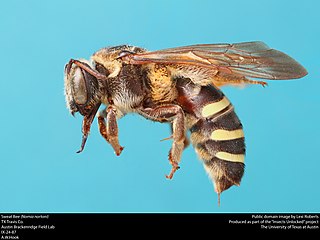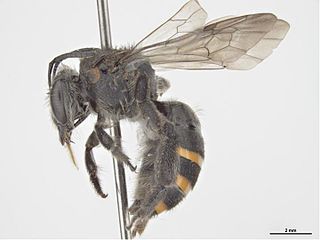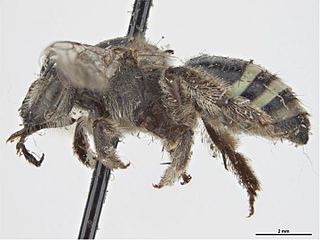
Halictidae is the second-largest family of bees with nearly 4,500 species. They are commonly called sweat bees, as they are often attracted to perspiration. Halictid species are an extremely diverse group that can vary greatly in appearance. These bees occur all over the world and are found on every continent except Antarctica. Usually dark-colored and often metallic, halictids are found in various sizes, colors and patterns. Several species are all or partly green and a few are red, purple, or blue. A number of them have yellow markings, especially the males, which commonly have yellow faces, a pattern widespread among the various families of bees. The family is one of many with short tongues and is best distinguished by the arcuate basal vein found on the wing. Females in this family tend to be larger than the males.

Frederick Smith was a British entomologist who worked at the zoology department of the British Museum from 1849, specialising in the Hymenoptera.
In Greek mythology, Nomia (Νομία) was a nymph of Arcadia, where the local people believed the Nomian Mountains to have been named after her.

Apiomerus is a genus of conspicuous, brightly colored assassin bugs belonging to the family Reduviidae. The species can be found in the United States ranging into tropical America. The common name bee assassins derives from their frequent habit of sitting and waiting upon flowers and taking bees as prey. The bright colors are aposematic, likely a warning to larger predators that a painful bite can be delivered.

Phalaenopsis pulcherrima is a species of orchid found from Hainan Island to western Malesia.

The alkali bee, Nomia melanderi, is a ground-nesting bee native to deserts and semi-arid desert basins of the western United States. It was described by Theodore Dru Alison Cockerell in 1906. While solitary, these bees nest near each other and can form extremely dense aggregations in areas with favorable conditions.
Lipotriches notiomorpha is a species of bee in the genus Lipotriches, of the family Halictidae. It is endemic to Sri Lanka, where it was first found from Anuradhapura district.
Hoplonomia westwoodi, sometimes known as Nomia (Hoplonomia) westwoodi, is a species of bee in the genus Hoplonomia, of the family Halictidae.
Lipotriches karnatakaensis is a species of bee in the genus Lipotriches, of the family Halictidae.

Nomia is a cosmopolitan genus of sweat bees in the family Halictidae. Many species have opalescent bands on the metasoma. Nomia species are moderate-sized bees that nest in the ground. Most species nest solitarily, but some species also nest communally where females share a nest but where there are no queen or worker castes. Nomia species are found Africa, tropical Asia, Australia, and in North America. There are about 130 species world wide.
Nomia aurata is a species of bee in the genus Nomia, in the family Halictidae.

Nomia tetrazonata is a species of sweat bee in the family Halictidae. It is found in Central America and North America.

Nomia nortoni is a species of sweat bee in the family Halictidae. It is found in Central America and North America.

Nomia aurantifer is a species of bee in the genus Nomia, in the family Halictidae. It occurs in Australia and Southeast Asia.

Nomia universitatis is a species of bee in the family Halictidae. It is native to the continental United States.

Nomia lyonsiae is a species of bee in the family Halictidae. It occurs in Australia and Polynesia.

Lipotriches rubella, or red-tailed small-nomia, is a species of bee in the genus Lipotriches, of the family Halictidae. It is known to occur in Chad as well as western, eastern and southern Africa.











